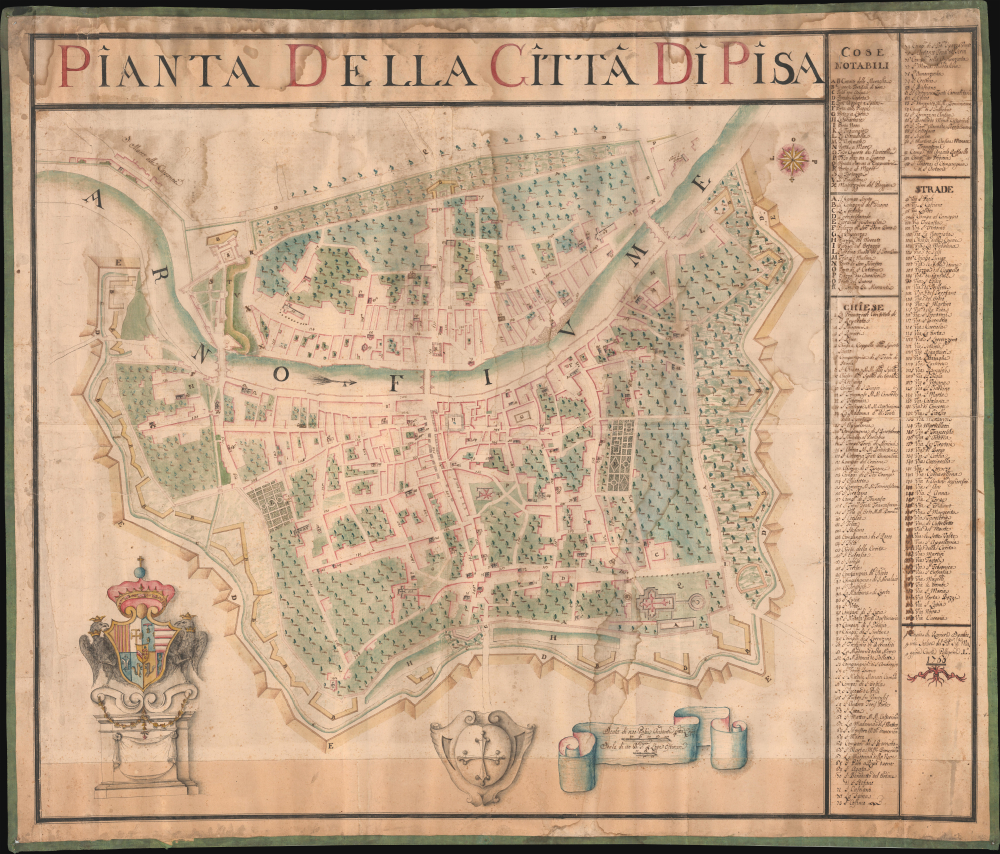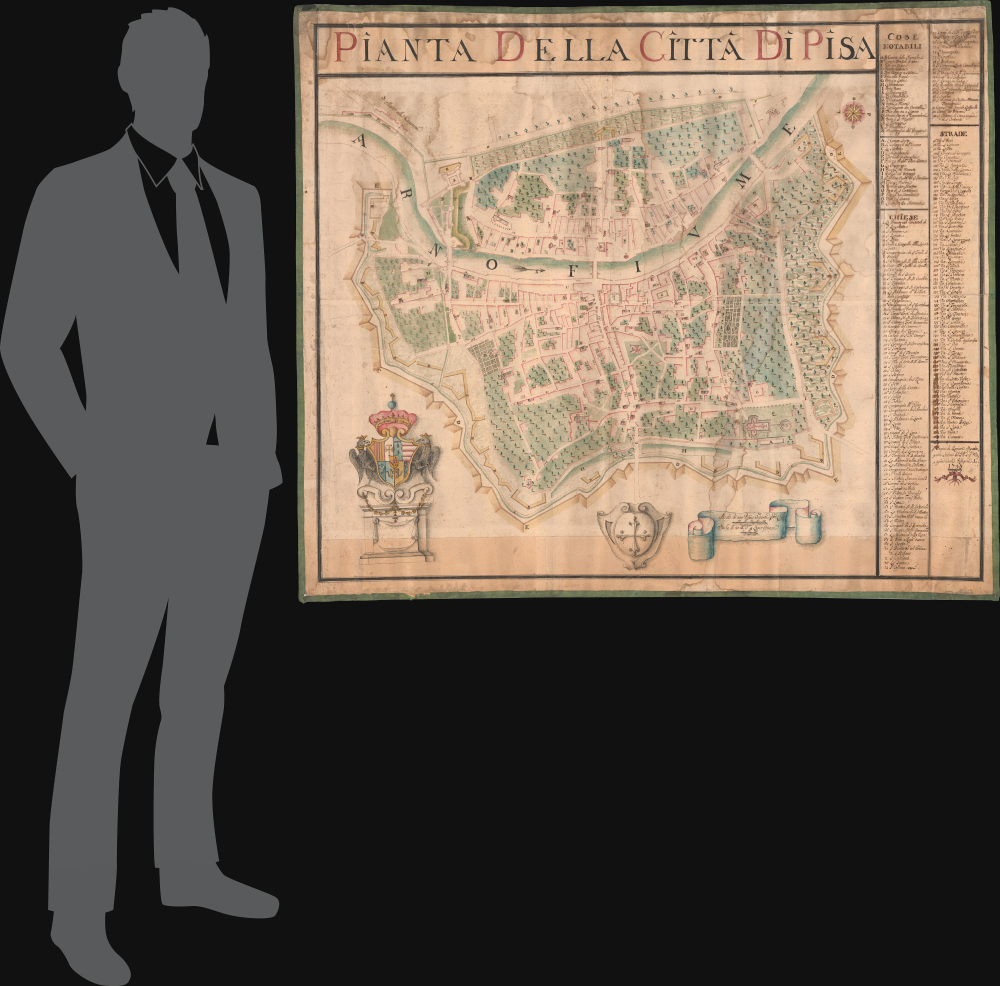1760 Pellegrini / Spadaccini Manuscript Wall Map of Pisa
Pisa-pellegrini-1760
Title
1760 (dated) 38 x 44.5 in (96.52 x 113.03 cm)
Description
A Closer Look
Oriented towards the south, the map covers the walled city of Pisa, which would have had roughly 13,000 inhabitants at this time ('Pisa' 1911 Encyclopedia Britannica, Vol. 21). The Arno River flows through the city towards the top and is spanned by three medieval bridges. Special prominence is given to the city's walls, likely due to the expertise of both Pellegrini and Spadaccini in military fortifications. 'La Fortezza' at the top-left, also known as the Fortezza Nuova or the Cittadella Nuova (now called the Giardino Scotto), was built after the Florentine conquest of the city in 1409. The nearby bridge, also fortified, came to be known as the Ponte della Fortezza. The bridge towards the middle of the city is, appropriately, called the Ponte di Mezzo, while the bridge at the left is the Ponte della Cittadella, named for the 'old' citadel on the side of the Arno leading out to the Ligurian Sea, the source of Pisa's wealth in the Medieval era.At the bottom towards the right is the Piazza del Duomo (now also known as the Piazza dei Miracoli) containing the city's cathedral, its famous campanile (the Leaning Tower of Pisa), the Baptistry (marked 'San Giovanni' here), and the Campo Santo Cemetery. Just above the piazza is the 'Giardino dei Semplici,' now the city's botanical gardens (Orto e Museo Botanico). In all, 36 important sites throughout the city are marked with letters, again with an emphasis on fortifications, city gates, and military sites such as the old and new citadels and the city arsenal, along with the University of Pisa (letter G 'La Sapienza'), piazze, palazzi, and prati. 95 churches and other religious sites are numbered and listed in an index at the right, along with 70 streets. The coat of arms of the city of Pisa appears at the bottom, while the Pellegrini family crest is drawn at the bottom left.
Publication History and Census
This map is ambiguously noted as a 'Copia di Ranieri Spadaccini Scolare del Sig.r Magg,re Conte Pellegrini' and dated July 1760. Presumably, it was a collaborative work between Spadaccini and Pellegrini, who also worked together on the design of at least one church in Pisa (Le chiese di Pisa). Aside from its size, the map is curious for its southward orientation, quite distinct from any printed maps of Pisa from the era. A once-in-a-lifetime discovery.CartographerS
Ranieri Spadaccini (fl. c. 1760 - 1807) was an Italian engraver and surveyor active in Florence and elsewhere in Tuscany in the late 18th century. Generally working in collaboration with other surveyors and engineers, he is credited with producing manuscript surveys and schematics of Pisa (1760), the villages of Vellano and Massa e Cozzile northwest of Florence (1782 - 1783), the doors of the city walls of Pisa and Livorno (1784), and the Coteto Vineyard near Livorno (1788). As an engraver, he prepared plates for the works of Machiavelli and Dante's La Divina commedia. Spadaccini appears to have been for a time in the employ of the Veronese nobleman Ignazio Pellegrini (1715 - 1790), with whom he prepared a survey of Pisa and designed at least one church in the city. More by this mapmaker...
Ignazio Mariano Baldassarre Pellegrini (September 22, 1715 - October 2, 1790) was an Italian nobleman, architect, surveyor, and scholar of the military arts. Born to the prominent Pellegrini family of Verona, which was said to be of German origin, Ignazio was the sixth child of Count Bertoldo Pellegrini and Countess Giulia Serego. After receiving a basic education at home, Pellegrini became a page to Princess Violante Beatrice of Bavaria at the Court of Tuscany. Ignazio showed an early aptitude for drafting, engineering, and the military arts, for which his family was famous. After the princess died, he was enlisted to work for the Grand Duke Giovan Gastone de' Medici, but soon afterwards decided to join the Austrian army to fight alongside his brother, where he fought in the War of the Polish Succession (1733 - 1738). Before and during his military service, he had undertaken a study of military fortifications that would influence his later career and life. While still enlisted in the army, he was commissioned to design a church in Ferrara, where his regiment was stationed. After the end of the war, he went to serve in the court of Giovan Gastone de' Medici and became the official Grand Ducal Engineer while maintaining his military role, reaching the rank of Colonel in the Grand Duke's royal regiment by 1769. He was tasked with a number of architectural projects by the Grand Duke, including completing the Palazzo Pitti and plans for a Cappella Reale to be built nearby, though this project was interrupted by the death of the duke and an economic crisis in 1763. Similar projects to build a grand staircase for the Medici's Uffizi complex in Florence and renovate the shops on the Ponte Vecchio were also left incomplete. Though his Florentine projects largely came to naught, Pellegrini did design numerous buildings (churches, homes, and tombs) in Pisa, especially, as well as Livorno and Verona. In 1776, Ignazio returned to Verona permanently, devoting himself to writing books on the history of art and architecture, along with an autobiography, all of which were unfinished at the time of his death. His architectural work was confined to the renovation of homes of other prominent Veronese families. At an unknown date, Pellegrini married Lucrezia del Lante of Pisa, with whom he had two children. Late in life, he was a well-known figure among the grandees of Verona due to his military exploits, travels, and service in the Medici court, but no doubt he was frustrated by the inability to complete his most ambitious literary and architectural works. Learn More...




